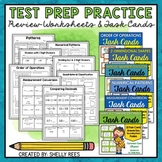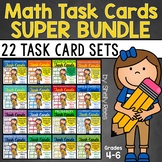Comparing Decimals and Number Form Task Cards and Posters
Shelly Rees
53.8k Followers
Grade Levels
4th - 6th, Homeschool
Subjects
Resource Type
Standards
CCSS5.NBT.A.3a
CCSS5.NBT.A.3b
Formats Included
- PDF
Pages
20 pages
Shelly Rees
53.8k Followers
Also included in
- If math test prep has you stressed out, this bundle is here to save the day! It is the perfect way to review the most-requested skills practice topics for 4th and 5th graders. The combination of skills review worksheets and task card sets is ideal for test prep season! By purchasing this test prepPrice $19.20Original Price $24.00Save $4.80
- Do your students LOVE task cards? Are you looking for a great way to add variety and solid reinforcement to math skill practice in your classroom? This Math Task Card Bundle is just what you need! This is a bundle of all 22 sets of my Math Task Card and Poster Sets. By purchasing this bundle, you aPrice $68.17Original Price $75.75Save $7.58
Description
This Decimal Comparison Task Card Set includes everything your students need to practice and master the skills of Decimal Comparison and Number Form! Task cards are extremely versatile and provide a great opportunity for practice and reinforcement of the skill.
Click here and SAVE by buying the Complete Bundle of Math Task Cards for Grades 4-6.
This helpful packet includes:
• 32 Task Cards (28 on-level and 4 challenge)
• Common Core Standard Poster
• Common Core “I Can” Poster
• Write Decimals Example Poster
• Compare Decimals Example Poster
• Answer Key
• Student Answer Worksheet
Aligned to:
CCSS.Math.Content.5.NBT.A.3a Read and write decimals to thousandths using base-ten numerals, number names, and expanded form, e.g., 347.392 = 3 × 100 + 4 × 10 + 7 × 1 + 3 × (1/10) + 9 × (1/100) + 2 × (1/1000)
CCSS.Math.Content.5.NBT.A.3b Compare two decimals to thousandths based on meanings of the digits in each place, using >, =, and < symbols to record the results of comparisons
The cards work best when printed on cardstock. Cut cards and laminate. Use in Math Centers, as individual work, or for early finishers. Cards #1-28 are on-level, while cards #29-32 are challenge tasks.
Two perfect companions to this set are:
Comparing Decimals Math Packet (5th Grade Common Core Math: 5.NBT.3)
Place Value & Number Form Math Centers, Activities, and Worksheets.
Check out these other great Task Card and Poster Sets:
Adding and Subtracting Decimals
Numerical Patterns Task Card and Poster Set
Measurement Conversion Task Card and Poster Set
Probability Task Card and Poster Set
2-Dimensional Shape Classification Task Card and Poster Set
Mean, Median, Mode, and Range Task Card and Poster Set
Numerical Expressions, Order of Operations Task Card and Poster Set
Elapsed Time Task Card and Poster Set
Coordinate Graphs and Ordered Pairs Task Card and Poster Set
Fraction Multiplication Task Card and Poster Set
3-Dimensional Shapes and Volume Task Card and Poster Set
Multiplication of Whole Numbers Task Card and Poster Set
Fraction Division Task Card and Poster Set
Division of Whole Numbers Task Card and Poster Set
Don't forget that leaving feedback earns you points toward FREE TPT purchases. I love that feedback!
Also, follow me and be notified when new products are uploaded. New products are always 50% off for the first 24 hours they are posted. It pays to follow me!
As always, please contact me with any questions!
Thank you so much,
Shelly Rees
Click here and SAVE by buying the Complete Bundle of Math Task Cards for Grades 4-6.
This helpful packet includes:
• 32 Task Cards (28 on-level and 4 challenge)
• Common Core Standard Poster
• Common Core “I Can” Poster
• Write Decimals Example Poster
• Compare Decimals Example Poster
• Answer Key
• Student Answer Worksheet
Aligned to:
CCSS.Math.Content.5.NBT.A.3a Read and write decimals to thousandths using base-ten numerals, number names, and expanded form, e.g., 347.392 = 3 × 100 + 4 × 10 + 7 × 1 + 3 × (1/10) + 9 × (1/100) + 2 × (1/1000)
CCSS.Math.Content.5.NBT.A.3b Compare two decimals to thousandths based on meanings of the digits in each place, using >, =, and < symbols to record the results of comparisons
The cards work best when printed on cardstock. Cut cards and laminate. Use in Math Centers, as individual work, or for early finishers. Cards #1-28 are on-level, while cards #29-32 are challenge tasks.
Two perfect companions to this set are:
Comparing Decimals Math Packet (5th Grade Common Core Math: 5.NBT.3)
Place Value & Number Form Math Centers, Activities, and Worksheets.
Check out these other great Task Card and Poster Sets:
Adding and Subtracting Decimals
Numerical Patterns Task Card and Poster Set
Measurement Conversion Task Card and Poster Set
Probability Task Card and Poster Set
2-Dimensional Shape Classification Task Card and Poster Set
Mean, Median, Mode, and Range Task Card and Poster Set
Numerical Expressions, Order of Operations Task Card and Poster Set
Elapsed Time Task Card and Poster Set
Coordinate Graphs and Ordered Pairs Task Card and Poster Set
Fraction Multiplication Task Card and Poster Set
3-Dimensional Shapes and Volume Task Card and Poster Set
Multiplication of Whole Numbers Task Card and Poster Set
Fraction Division Task Card and Poster Set
Division of Whole Numbers Task Card and Poster Set
Don't forget that leaving feedback earns you points toward FREE TPT purchases. I love that feedback!
Also, follow me and be notified when new products are uploaded. New products are always 50% off for the first 24 hours they are posted. It pays to follow me!
As always, please contact me with any questions!
Thank you so much,
Shelly Rees
Total Pages
20 pages
Answer Key
Included
Teaching Duration
N/A
Report this resource to TPT
Reported resources will be reviewed by our team. Report this resource to let us know if this resource violates TPT’s content guidelines.
Standards
to see state-specific standards (only available in the US).
CCSS5.NBT.A.3a
Read and write decimals to thousandths using base-ten numerals, number names, and expanded form, e.g., 347.392 = 3 × 100 + 4 × 10 + 7 × 1 + 3 × (1/10) + 9 × (1/100) + 2 × (1/1000).
CCSS5.NBT.A.3b
Compare two decimals to thousandths based on meanings of the digits in each place, using >, =, and < symbols to record the results of comparisons.







